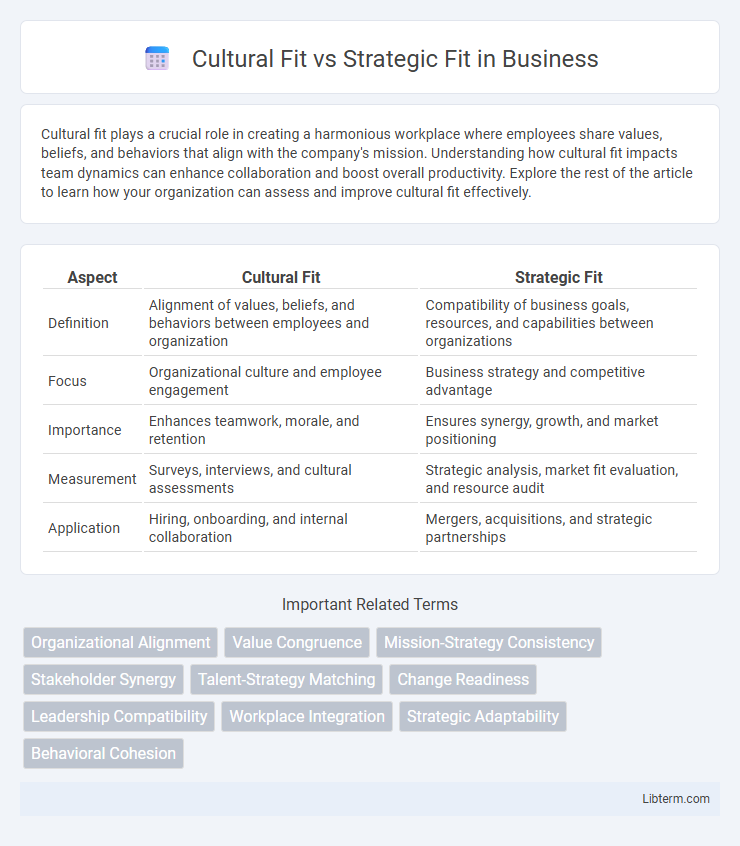Cultural fit plays a crucial role in creating a harmonious workplace where employees share values, beliefs, and behaviors that align with the company's mission. Understanding how cultural fit impacts team dynamics can enhance collaboration and boost overall productivity. Explore the rest of the article to learn how your organization can assess and improve cultural fit effectively.
Table of Comparison
| Aspect | Cultural Fit | Strategic Fit |
|---|---|---|
| Definition | Alignment of values, beliefs, and behaviors between employees and organization | Compatibility of business goals, resources, and capabilities between organizations |
| Focus | Organizational culture and employee engagement | Business strategy and competitive advantage |
| Importance | Enhances teamwork, morale, and retention | Ensures synergy, growth, and market positioning |
| Measurement | Surveys, interviews, and cultural assessments | Strategic analysis, market fit evaluation, and resource audit |
| Application | Hiring, onboarding, and internal collaboration | Mergers, acquisitions, and strategic partnerships |
Understanding Cultural Fit: Definition and Importance
Cultural fit refers to the alignment between an employee's values, beliefs, and behaviors with the core values and culture of an organization, ensuring harmonious collaboration and job satisfaction. Understanding cultural fit is crucial because it enhances team cohesion, reduces turnover rates, and drives employee engagement by fostering a supportive work environment. Companies that prioritize cultural fit during hiring see significant improvements in productivity and long-term organizational success.
Defining Strategic Fit: Key Concepts
Strategic fit refers to the alignment between a company's internal resources, capabilities, and external opportunities in the competitive environment, ensuring that business strategies are effectively executed. Key concepts include resource complementarity, market positioning, and synergy realization, which drive sustainable competitive advantage and long-term growth. Assessing strategic fit involves analyzing how well organizational strengths match industry demands and strategic objectives to optimize performance and value creation.
The Impact of Cultural Fit on Organizational Success
Cultural fit significantly influences employee engagement, retention, and overall organizational performance by aligning individual values with company norms. Research indicates companies with strong cultural alignment experience up to 30% higher productivity and reduced turnover rates by 40%. Ensuring cultural fit fosters collaboration, innovation, and a cohesive work environment critical for long-term strategic success.
Strategic Fit: Aligning Business Goals and Resources
Strategic fit involves aligning a company's resources and capabilities with its long-term business goals to achieve maximum operational efficiency and competitive advantage. It requires a thorough analysis of market conditions, internal strengths, and external opportunities to ensure that strategic initiatives are viable and sustainable. Effective strategic fit enhances decision-making processes, optimizes resource allocation, and drives growth by integrating organizational objectives with external demands.
Key Differences Between Cultural Fit and Strategic Fit
Cultural fit refers to the alignment between an employee's values, beliefs, and behaviors with the organizational culture, while strategic fit focuses on how well an employee's skills and experiences match the company's strategic goals and objectives. Key differences include cultural fit emphasizing interpersonal compatibility and shared values, whereas strategic fit prioritizes skill sets and business direction alignment. Organizations balance both by ensuring employees not only adapt to the company's environment but also contribute effectively to long-term strategic success.
When to Prioritize Cultural Fit Over Strategic Fit
Prioritize cultural fit over strategic fit when long-term collaboration and employee retention are critical, as shared values and company culture foster better teamwork and engagement. In industries reliant on creativity, innovation, or customer service, cultural alignment often drives superior performance and adaptability. Organizations undergoing transformation or seeking to strengthen internal cohesion benefit most from emphasizing cultural fit to ensure seamless integration and sustained growth.
The Risks of Overlooking Either Fit
Overlooking cultural fit can lead to employee dissatisfaction, reduced collaboration, and high turnover rates, undermining long-term organizational success. Ignoring strategic fit risks misaligned goals, inefficient resource allocation, and failure to adapt to market changes, threatening competitive advantage. Balancing both fits ensures cohesive teams and sustainable growth in dynamic business environments.
Real-World Examples: Cultural Fit vs Strategic Fit in Action
Cultural fit and strategic fit play crucial roles in mergers and acquisitions, as seen in Disney's acquisition of Pixar, where strong cultural alignment fostered innovation and collaboration. In contrast, the AOL-Time Warner merger exemplifies strategic fit without cultural harmony, resulting in clashing management styles and lost value. Companies like Google emphasize cultural fit in hiring to maintain innovation, while IBM prioritizes strategic fit when expanding into new markets to ensure alignment with long-term goals.
Integrating Cultural and Strategic Fit for Optimal Results
Integrating cultural fit and strategic fit enhances organizational alignment, fostering both employee engagement and long-term business success. Emphasizing cultural fit ensures values and behaviors resonate with the company's mission, while strategic fit aligns resources and capabilities with market opportunities. Combining these fits drives cohesive decision-making, maximizes innovation potential, and sustains competitive advantage.
Best Practices for Balancing Both Fits in Decision-Making
Effective decision-making requires integrating cultural fit, emphasizing shared values and behaviors, with strategic fit, which aligns resources and capabilities with organizational goals. Best practices include conducting thorough organizational culture assessments alongside strategic analysis to ensure both dimensions are addressed during hiring or partnerships. Leveraging cross-functional teams and continuous feedback loops enhances alignment, promoting sustainable performance and long-term success.
Cultural Fit Infographic

 libterm.com
libterm.com